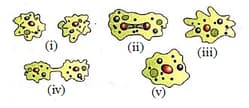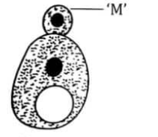EASY
Earn 100
Study the given figures representing the process of binary fission in Amoeba.
Arrange the figures in the correct sequence and select the correct answer.

(a)(iv), (iii), (i), (ii), (v)
(b)(iii), (iv), (i), (ii), (v)
(c)(v), (iii), (ii), (iv), (i)
(d)(iv), (iii), (ii), (v), (i)
50% studentsanswered this correctly
Important Questions on Reproduction in Organisms
EASY
MEDIUM
MEDIUM
Statement I: The binary fission of Euglena is called homothetogenic fission because the daughter euglenae are like mirror images.
Statement II: Binary fission in Paramecium is known as perkinetal fission because it occurs at right angles to the kineties.
EASY
EASY
Identify the asexual reproductive structure in the following diagram:

MEDIUM
Lateral branches arise from the basal and underground part of the main stem
Branches bent and grow downwards
Branches grow obliquely upwards
Lateral branches arise from the base of the main axis and are aerial
EASY
EASY
EASY
EASY
MEDIUM
EASY
MEDIUM
(i) During favourable conditions Paramecium stops feeding after attaining its maximum growth.
(ii) At first the micronucleus divides by amitosis and the macronucleus divides into two daughter nuclei by mitosis.
(iii) The proter receives the anterior contractile vacuole, cytopharynx and cytostome from its parent individuals.
(iv) Before karyokinesis a transverse constriction appears in the middle of the body.
EASY
EASY
MEDIUM
MEDIUM
EASY
EASY
Match the following
| List-I | List-II | ||
| (A) | Longitudinal binary fission | (I) | Paramoecium |
| (B) | Transverse binary fission | (II) | Amoeba |
| (C) | Sporogony | (III) | Pleurobrachia |
| (D) | Sporulation | (IV) | Plasmodium |
| (V) | Euglena |

